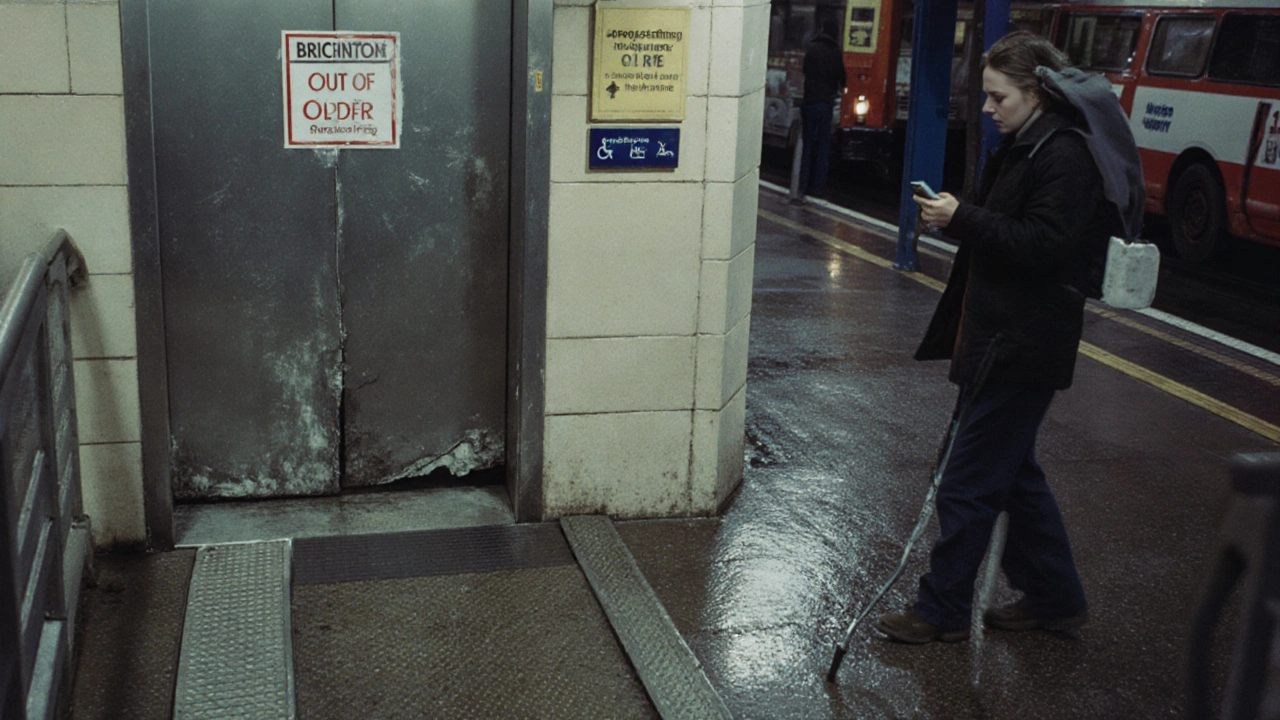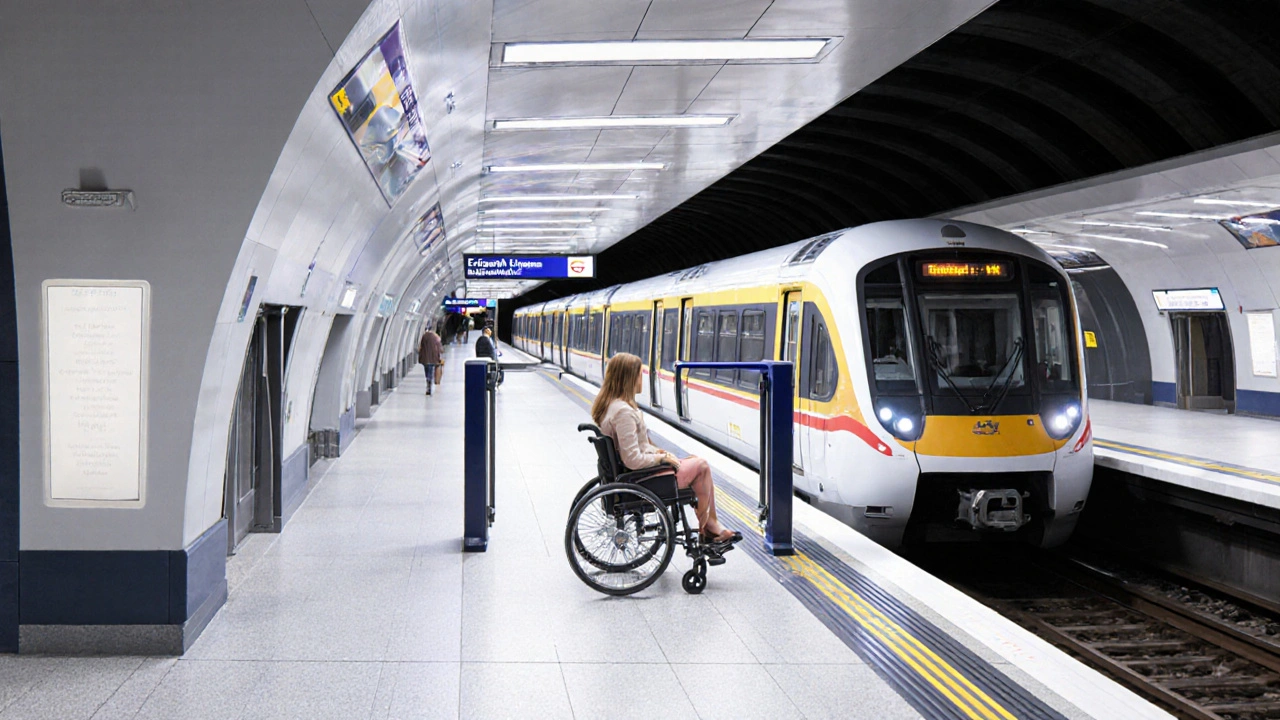Getting around London shouldn’t mean climbing stairs, waiting for help, or worrying you’ll get stuck. If you use a wheelchair, have trouble walking, or just need a little extra support, London’s transport system has made real progress - but it’s still a patchwork. Some stations feel like they were built for everyone. Others? Not so much. Here’s what actually works, what doesn’t, and how to plan your trip so you don’t end up stranded on a platform.
Step-Free Stations: What’s Actually Available
As of 2025, over 100 London Underground and Overground stations are fully step-free. That means no stairs at all - from street level to the platform. You can roll, walk, or push a stroller without lifting anything. Major hubs like King’s Cross St. Pancras, Oxford Circus, and Waterloo have had step-free access for years. So do newer stations like Crossrail’s Bond Street and Tottenham Court Road.
But here’s the catch: not every station on a line is step-free. Take the Central Line. It runs from West Ruislip to Epping, but only 8 out of 49 stations are fully step-free. If you’re heading to Leytonstone, you’ll need to transfer to a bus or find a different route. The same goes for parts of the Northern Line - Bank and Camden Town are step-free, but Angel and Mornington Crescent aren’t. You can’t assume a line is accessible just because one station on it is.
Transport for London (TfL) keeps an updated list of step-free stations on their website. Print it. Save it. Or better yet, use the TfL Go app. It highlights step-free routes in green and warns you if your planned journey includes stairs. Don’t trust memory. Stations change. Ramps get blocked. Elevators break.
Ramps and Lifts: Don’t Assume They Work
Lifts and ramps sound simple. But in practice, they’re the weakest link. In 2024, TfL reported that 18% of lifts across the network were out of service on any given day. That’s nearly 1 in 5. At stations like Brixton or Stratford, you might find a working lift one week and a sign saying “Out of Order - Use Alternative Route” the next.
Ramps are more reliable - but not always present. At older stations like Piccadilly Circus or Leicester Square, you’ll find steep, narrow ramps that are hard to navigate with a heavy suitcase or a mobility scooter. Some ramps are so steep they’re illegal under current accessibility guidelines, but they’ve never been fixed because the station structure can’t be easily modified.
Pro tip: Always check the status of lifts before you leave. TfL’s website and app show real-time elevator status. If the lift is down, the app will suggest a detour. If you’re calling for help, ask for the nearest accessible station - not just the next one. Sometimes it’s faster to walk 10 minutes to a step-free station than wait 45 minutes for a broken lift to be fixed.
Assistance: How to Get Help, When You Need It
London Transport offers a free assistance service called Helping Hand. It’s not automatic. You have to book it. And you need to do it in advance - at least 24 hours before your trip. You can book online, through the TfL app, or by calling 0343 222 1234.
What does it cover? Staff meet you at the entrance, help you through ticket gates, guide you to the platform, and wait with you until your train arrives. They’ll even help you board if the gap between the train and platform is too wide. At major stations, they have mobility scooters you can borrow for short distances.
But here’s what no one tells you: assistance isn’t guaranteed at every station. Smaller Overground or DLR stations don’t always have staff on hand. If you’re traveling to a station like New Cross Gate or Canada Water, you’ll need to confirm that assistance is available there. Don’t assume. Ask. And always have a backup plan.
For spontaneous trips - like a sudden doctor’s appointment or a last-minute meeting - you can still get help. Walk up to any station staff member and say, “I need assistance.” They’ll call for help. But response times vary. At busy stations like Victoria or Liverpool Street, you might wait 15-20 minutes. At quieter ones, it could be 45.

What About Buses and Trams?
If you’re looking for reliability, buses and trams are often better than the Tube. All London buses are low-floor and have ramps. Every one has a designated wheelchair space and audio-visual announcements. You don’t need to book - just wave at the driver. They’ll stop, lower the ramp, and help you board.
Trams in Croydon and Wimbledon are similarly accessible. They’re quieter, slower, and often have fewer stairs to navigate. If you’re traveling between South London boroughs, the tram might be your best bet. Plus, you can bring a companion for free - no extra fare.
But don’t expect perfection. Buses can be late. Ramps sometimes jam. Drivers aren’t always trained well. I once waited 40 minutes for a bus because the ramp wouldn’t deploy. The driver kept trying - and apologizing - but didn’t know how to fix it. That’s why it’s smart to have a second option ready. Apps like Citymapper show real-time bus delays and alternative routes.
Planning Your Trip: Tools and Tips
Here’s what works in 2025:
- TfL Go app: Shows step-free routes, live lift status, and helps you book assistance. It’s the most reliable tool.
- Citymapper: Gives you multiple route options, including step-free alternatives. Highlights which routes avoid stairs entirely.
- TfL’s step-free guide: Download the PDF. It’s updated monthly. Print it if you’re not sure about data coverage.
- Travelcards and Oyster: No extra cost for assistance or accessibility features. You pay the same fare as everyone else.
Plan your journey for off-peak hours if you can. Rush hour means crowded platforms, packed lifts, and staff stretched thin. A 10 a.m. trip on a Tuesday is far easier than a 5 p.m. one on a Friday.
Carry a small card or note that says: “I need assistance. Please help me board.” Some people with invisible disabilities - like chronic pain or balance issues - don’t use wheelchairs but still need help. Staff are trained to respond to these requests. Don’t feel like you have to explain everything.

Common Problems and How to Fix Them
Here are the top 5 issues travelers face - and how to avoid them:
- Lifts are out of order: Always check the app before you leave. If it’s broken, reroute. Use a bus or another line.
- Staff aren’t available: Book assistance in advance. Don’t rely on walking up and hoping someone’s there.
- Platform gaps are too wide: Ask for help boarding. Staff have bridge plates to fill the gap. Don’t try to jump or rush.
- Signage is confusing: Step-free routes aren’t always clearly marked. Look for the blue wheelchair symbol. If you don’t see it, ask.
- Weather affects access: Snow, rain, or ice can block ramps or make surfaces slippery. Wear good shoes. Bring a small towel or mat to place over wet surfaces.
One real story: A woman with multiple sclerosis tried to get from Camden Town to King’s Cross on a rainy day. The lift was broken. The ramp was slippery. She called for help. Staff arrived in 12 minutes, cleared the ramp with a mop, and walked her slowly to the platform. She made her train. But she said, “I shouldn’t have had to fight for this. It’s 2025.”
She’s right. Progress has been made - but it’s not complete. And it shouldn’t be up to you to be the one pushing for change. The system should work without you having to ask.
What’s Coming Next?
TfL has pledged to make 50 more stations step-free by 2030. That includes key hubs like Barking, Hounslow, and Wimbledon. Newer stations are being built with accessibility as standard - no exceptions. The Elizabeth Line was designed from the ground up for everyone. No stairs. No ramps. Just smooth, level access.
But funding is tight. And older stations - especially those under historic buildings - are expensive to retrofit. That’s why progress is slow. What you see today is the result of decades of advocacy. And it’s still not enough.
If you’re a regular user of London Transport, your feedback matters. Report broken lifts. Tell TfL when staff aren’t helpful. Use their online feedback form. Every report adds pressure to improve.
Final Thought: You Deserve to Move Freely
London is one of the most vibrant cities in the world. But its transport system still treats accessibility like an afterthought - not a right. You shouldn’t have to plan your whole day around whether a lift is working. You shouldn’t have to call ahead just to get on a train.
But until the system catches up, you have tools. You have rights. And you have the right to ask for help. Use them. Plan ahead. Know your options. And don’t let anyone make you feel like your mobility is a burden. It’s not. It’s just part of getting around.
Are all London Underground stations step-free?
No. As of 2025, only about 100 of the 270+ stations on the London Underground and Overground are fully step-free. Major hubs like King’s Cross and Oxford Circus are accessible, but many older stations still have stairs. Always check the TfL Go app or website before you travel.
How do I book assistance on London Transport?
You can book assistance through the TfL Go app, online at tfl.gov.uk/assistance, or by calling 0343 222 1234. You need to book at least 24 hours in advance. Assistance includes staff meeting you at the entrance, helping you to the platform, and ensuring you board safely.
Do I need to pay extra for accessibility services?
No. All accessibility services - including step-free access, ramps, lifts, and staff assistance - are free. You pay the same fare as any other passenger. There are no additional charges for using these services.
Can I use a mobility scooter on the Tube?
Yes, if your mobility scooter meets TfL’s size and weight limits (maximum 70cm wide, 120cm long, and 250kg including rider). You must book assistance in advance. Scooters are allowed on step-free stations and buses, but not on all trains during peak hours due to crowding.
What should I do if a lift is broken when I arrive?
Use the TfL Go app to find the nearest step-free station. If you’re already at the station, ask staff for help - they can call for a shuttle bus or suggest an alternative route. Never try to use stairs if you can’t safely manage them. There’s always another way.
Are buses in London accessible for wheelchair users?
Yes. All London buses are low-floor with automatic ramps, designated wheelchair spaces, and audio-visual announcements. No booking is needed - just wave to the driver, and they’ll stop and lower the ramp. You can bring a companion for free.
Is the Elizabeth Line fully accessible?
Yes. The Elizabeth Line was designed as a fully accessible route from the start. All 41 stations have step-free access, level boarding, wide gates, and working lifts. It’s currently the most accessible line in London’s network.
Can I bring a guide dog on London Transport?
Yes. Guide dogs and other registered assistance animals are welcome on all London Transport services, including the Tube, buses, trams, and trains. Staff are trained to assist passengers with guide dogs and will not refuse entry.
